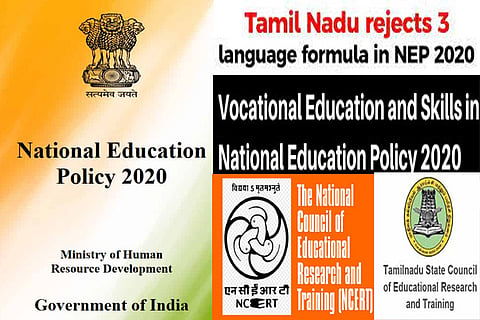

Chennai
While the three-language formula which NEP-2020 intends to continue and the emphasis on schooling in one’s mother tongue/native language until Grade 5 and, if possible, until Grade 8 could be contentious, the policy also clearly states that ‘no language will be imposed on any state.’ The three languages to be learnt by children will be the choice of the states, regions and the students as long as two of the languages are native to India thus giving no room for Hindi imposition as feared by political parties in the state.
The more worrisome and regressive aspect of NEP-2020 is its obstinate insistence in promoting Sanskrit, an obsolete language used nowhere in India except in certain religious practices, as one of the language options in all schools across the country. But, in the interest of the student community and society at large, policymakers, as well as TN politicians and academicians, should not get mangled in the language-tussle and lose sight of the larger objective of NEP-2020, which is to transform education and learning process in the country.
The new policy paves way for a distinct shift in the way school education is approached from one that depends on rote learning to evaluate a student’s ability to one that promotes critical thinking and problem-solving skills, which are the need of the hour. Some of the laudable changes proposed in NEP-2020 include secondary school students getting to choose the subjects they study which include arts and crafts, physical education and vocational skills. The policy intends to remove the hard separation between curricular, co-curricular and extra-curricular activities among arts, humanities and sciences and between vocational and academic streams at the secondary level. Assessment of student capabilities is also set to undergo a sea change with the progress card of the future set to be a holistic, multidimensional report that reflects the uniqueness of each learner in various domains. A welcome shift in the board exam pattern is to allow class 10 and 12 students to take board exams in subjects of their choice and get two attempts at the board exams in the same academic year. The policy also suggests a modular board exam to further reduce pressure on students.
The proposal to form school complexes/clusters with a secondary or higher secondary school sharing its resources with smaller schools and anganwadis in the surrounding areas could pave way for efficient resource sharing besides providing access for students and faculty in smaller schools to those available in larger campuses such as libraries, counsellors etc. without additional financial burden.
The Indian student of the future needs to be equipped with the ability to address and solve global problems and take these solutions in a language and the format that is universally accessible. The biggest challenge for the NCERT and SCERT in implementing the policy would be to get over petty-minded politics over language and instead focus on enhancing the quality of education that could prepare our students to compete with the best in the world.
Visit news.dtnext.in to explore our interactive epaper!
Download the DT Next app for more exciting features!
Click here for iOS
Click here for Android